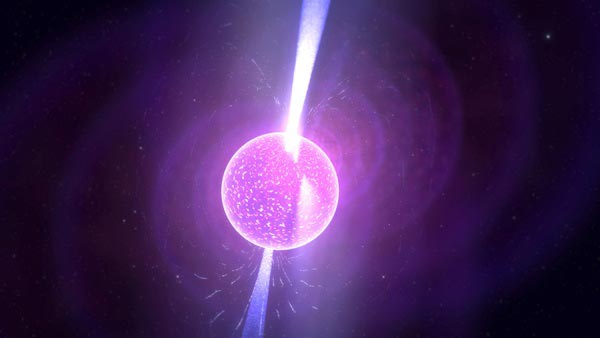Neutron stars are strange and violent phenomena that defy the laws of physics, and new discoveries reveal that these bizarre nightmares are far more deadly than previously believed, with the power to destroy planets and even other stars.
A neutron star is the collapsed core of a giant star which before collapse had a total of between 10 and 29 solar masses. They are the smallest and densest stars, not counting hypothetical quark stars and strange stars. Neutron stars have a radius of the order of 10 kilometres (6.2 mi) and a mass lower than 2.16 solar masses. They result from the supernova explosion of a massive star, combined with gravitational collapse, that compresses the core past white dwarf star density to that of atomic nuclei.
Once formed, they no longer actively generate heat, and cool over time; however, they may still evolve further through collision or accretion. Most of the basic models for these objects imply that neutron stars are composed almost entirely of neutrons (subatomic particles with no net electrical charge and with slightly larger mass than protons); the electrons and protons present in normal matter combine to produce neutrons at the conditions in a neutron star.
They are partially supported against further collapse by neutron degeneracy pressure, a phenomenon described by the Pauli exclusion principle, just as white dwarfs are supported against collapse by electron degeneracy pressure. However neutron degeneracy pressure is not sufficient to hold up an object beyond 0.7M☉ and repulsive nuclear forces play a larger role in supporting more massive neutron stars. If the remnant star has a mass exceeding the Tolman–Oppenheimer–Volkoff limit, it continues collapsing to form a black hole.
Third stream
There are thought to be around 100 million neutron stars in the Milky Way, a figure obtained by estimating the number of stars that have undergone supernova explosions. However, most are old and cold, and neutron stars can only be easily detected in certain instances, such as if they are a pulsar or part of a binary system. Slow-rotating and non-accreting neutron stars are almost undetectable; however, since the Hubble Space Telescope detection of RX J185635-3754, a few nearby neutron stars that appear to emit only thermal radiation have been detected. Soft gamma repeaters are conjectured to be a type of neutron star with very strong magnetic fields, known as magnetars, or alternatively, neutron stars with fossil disks around them.




